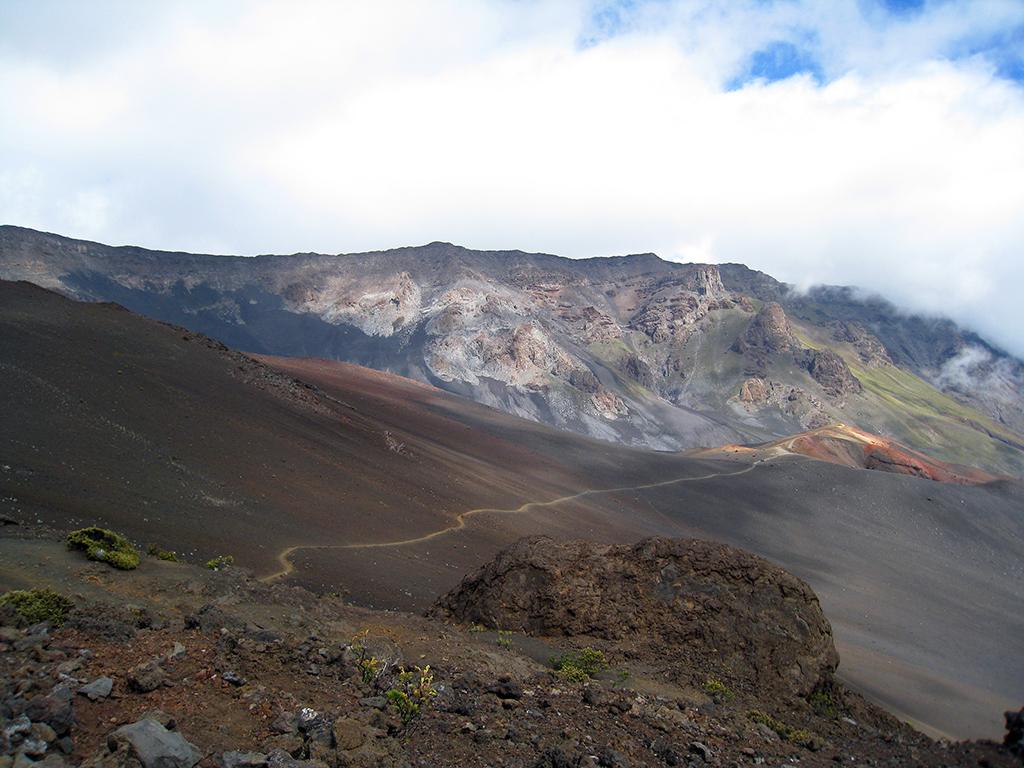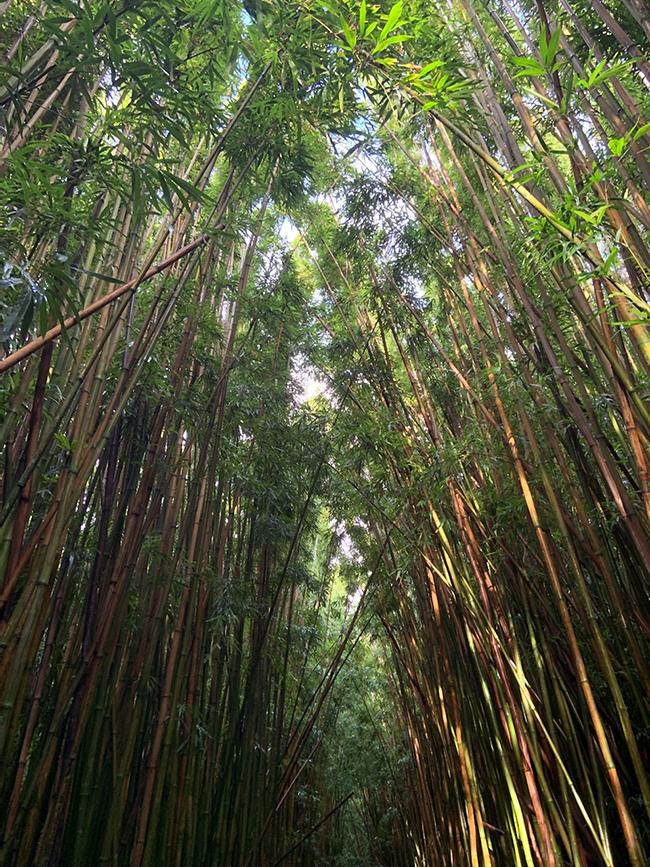Haleakalā National Park offers hikes lasting anywhere from 10 minutes to several days. The trails in the park’s two districts lead you to diverse vistas of lush tropical vegetation, a thick forest of tall bamboo, sparkling waterfalls tumbling down volcanic cliffs, and a colorful and barren volcanic landscape dotted with cinder cones and a sprinkling of rare silversword ('ahinahina).
Summit District

A trail through the colorful volcanic landscape of the Summit District, Haleakalā National Park / NPS file
With 30 miles (48.3 km) of trails, the Summit District provides the most hiking options.
According to park staff:
You can hike in the native shrubland, looking for native forest birds and endemic plants, or in the aeolian cinder desert, exploring the geologic history of the volcano.
Trails are strenuous in the Summit Area because the high-elevation causes a lower concentration of oxygen in each breath. Altitude sickness is a concern. Be on guard for symptoms: nausea, headache, dizziness, and shortness of breath. Pregnant women and people with heart or respiratory conditions should consult their doctor before visiting and hiking in the Summit Area. When beginning your hike on a downward slope, allow for twice the time hiking to get out, e.g. 15 minutes hiking down + 30 minutes up = 45-minute hike. Soft cinder trails create hiking conditions similar to walking on a beach in some areas.
Temperatures commonly range between 30 to 65 degrees F (-1 to +18 degrees C), and can reach below freezing at any time with the wind-chill factor. Hypothermia is a danger. Hikers must be properly prepared for high altitudes and cold, rainy conditions. Weather in the Summit Area is unpredictable and ever-changing. Prepare for harsh UV rays, wind, rain, and cold temperatures year-round.
Alpine Desert Hikes
Pā Ka‘oao Trail
Distance Roundtrip: 0.4 mile (0.64 km); 100 feet (30 m) elevation gain
Hike up the pu‘u (hills denoting old eruption sites) next to Haleakalā Visitor Center to view ancient rock wall shelters and the crater.

Hikers on the Keonehe‘ehe‘e (Sliding Sands) Trail, Haleakalā National Park / NPS - Hannah Mousavi
Keonehe‘ehe‘e (Sliding Sands) Trail
Distance Roundtrip: 11 miles (17.8 km); 7,990 ft (2,436 m) elevation change
If you wish, you can hike downhill into the crater to just the first overlook, 0.5 mile (0.8 km) roundtrip. The trailhead is in the Haleakalā Visitor Center parking lot near the road.
Or, you can take this popular full-day hike to view other points of interest, such as the “crater floor” (what we call a crater is actually a valley floor carved by water and landslides since the original crater was long-ago eroded away) 3.9 miles (6.3 km) down one-way; “Pele’s Paint Pot” 5.7 miles (9.2 km) in an area known for its vibrant colors of cinder; and Kawilinau (also about 5.7 miles/9.2 km) known as the “bottomless pit,” about 65 feet (19.8 m) deep.
Subalpine Shrubland Hikes
Leleiwi Overlook Trail
Distance Roundtrip: 0.3 mile (0.48 km km); 100 ft (30 m) elevation change
This trail is a short walk to a crater viewpoint.
Halemau‘u Trail
Distance Roundtrip: 2.2 miles (3.6 km); 400 ft (123 m) elevation change
This trail is a rocky path to another crater viewpoint. A popular destination on this hike is a natural land bridge commonly referred to as "Rainbow Bridge," about 0.25 miles (0.4 km) from the first crater viewpoint. Hiking past this will take you down switchbacks carved into the crater walls. You can hike 2 miles further down to the crater floor for a total 6.2 miles (~10 km) roundtrip.
Supply Trail
Distance Roundtrip: 4.6 miles (7.4 km); 975 ft (297 m) elevation change
Hike to the junction with the Halemau'u Trail.
Hosmer Grove
Distance Roundtrip: 0.54 mile (0.87 km) loop; 50 ft (15 m) elevation change
Compare non-native trees (planted before the park’s establishment, to control erosion) and native shrubland. View honeycreepers found nowhere else on earth.
Kīpahulu District
Getting to the remote Kīpahulu District requires about a 3-hour drive along the narrow, winding Hāna Highway. Once you have arrived, you have the option of hiking two trails:
Pīpīwai Trail
Distance Roundtrip: 4 miles (6.4 km); 800 feet (244 m) elevation gain
This is the trail with which you might be most familiar, if you’ve viewed photos of a narrow line of boardwalk wending its way between a thick forest of spindly, 25-foot-tall (7.6 m) bamboo trees. You’ll see the bamboo a mile from the trailhead, and Waimoku Falls is at trail’s end, tumbling down 400 feet (122 m) of mossy green cliff face to a very shallow, rocky pool below. This trail is considered moderately strenuous due to the often-slick, rocky, uneven nature of the trail with exposed tree roots in places. Sturdy shoes/boots are recommended.

The bamboo forest along the Pīpīwai Trail, Haleakalā National Park / NPS file
Kūloa Point Trail
Distance Roundtrip: 0.5 mile (0.8 km); 80 feet (24.4 m) elevation gain
This trail leaves the Kīpahulu Visitor Center and continues past a Hawaiian cultural demonstration area to Kuloa Point at the mouth of 'Ohe'o Gulch. Here, you will find beautiful ocean views and archaeological sites. This trail is popular for viewing the Pools of 'Ohe'o.
Trails For Pack Animals
Horses, mules, and donkeys are permitted as pack animals on the Keoneheʻeheʻe Trail, Halemauʻu Trail, Supply Trail, and the Kīpahulu horse trail from Hwy 31 to the Palikea Overlook. All waste produced by pack animals must be removed from parking areas and trailheads. No group may have more than 12 pack animals. Riders, commercial operators, and owners are responsible for the removal of dead or injured stock within 72 hours. Pets of any other kind are prohibited on all trails.
Traveler’s Notes:
- Hiking groups are limited to 12 people. If your group is larger than 12 you will need to split into two or more groups and separate each group by 30 minutes on the trail.
- All native forests have ʻōhiʻa trees. So, if you are coming to Maui from the Big Island and plan to visit a native forest, please clean and remove dirt and debris from shoes, clothing, and equipment. Also, spray your boots, clothing, and equipment with a 70% alcohol spray. Why do these things? Because this helps deter Rapid ʻŌhiʻa Death (ROD), a fungus that kills native ʻōhiʻa trees, and has been detected on the Big Island. This disease has a 100% mortality rate.





